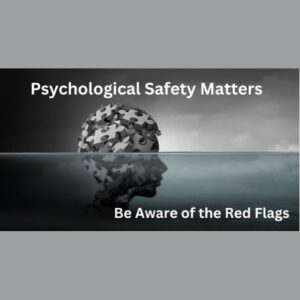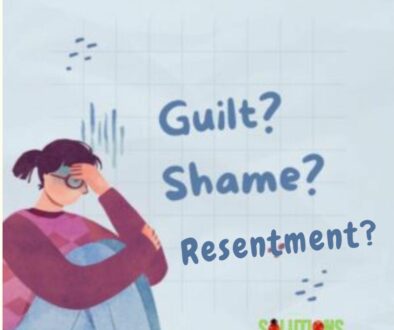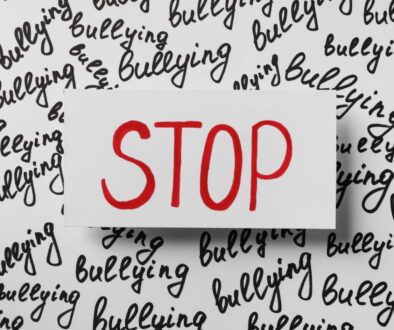Psychological Safety: Strategies to Thrive at Work and Home

“Lacking a sense of psychological safety, people shut down, often without realizing it. They are less likely to seek or accept feedback and also less likely to experiment, to discuss errors, and to speak up about potential or actual problems.”
Christine Porath, professor, at Kenan-Flagler Business School, University of North Carolina and author of Mastering Civility
The topic of psychological safety often emerges when I work with my counselling therapy clients. Many of them struggle to work in toxic environments while others are often in relationships with emotional, mental, and sometimes physical abuse.
How we are treated shapes our mental health, both at work and in our personal lives. Our self-respect, self-care, and the way others treat us impact our sense of belonging and emotional well-being. To thrive, we must surround ourselves with individuals who offer support, kindness, and honesty. Central to this nurturing environment is psychological safety—a state where individuals feel safe to speak, express themselves, and take risks without fear of judgment or punishment.
The importance of psychological safety cannot be overstated.
ONE: The Importance of Psychological Safety
Psychological safety is the belief that one will not be humiliated or punished for sharing ideas, asking questions, or making mistakes. Dr. Amy C. Edmondson’s groundbreaking work on this concept in The Fearless Organization: Creating Psychological Safety in the Workplace for Learning, Innovation, and Growth highlights how creating a psychologically safe workplace can foster innovation, collaboration, and creativity. But the principle applies not just at work but in our homes, schools, community, and country.
Psychological Safety at Work: Key Benefits
- Creativity and Problem-Solving: When employees feel psychologically safe, they can freely share ideas and take creative risks without fear of ridicule. This freedom promotes innovation and problem-solving, especially in complex or high-pressure environments.
- Open Communication and Collaboration: A safe workplace encourages open communication, cooperation, and effective decision-making, resulting in better teamwork and outcomes.
- Reduced Stress and Burnout: According to The Wiley Workplace Intelligence Report (2023), psychological safety in the workplace is directly correlated with lower levels of burnout and stress, leading to improved employee well-being and retention.
- Increased Job Satisfaction: Employees are more likely to feel fulfilled and valued when they are respected and heard, leading to greater satisfaction in their roles.
- Improved Performance and Productivity: Teams that are supported and feel psychologically safe tend to have higher performance and productivity, as employees can fully engage with their work.
Psychological Safety at Home: Key Benefits
- Caring Relationships: Trust, warmth, and emotional support contribute to positive relationships at home. When we feel safe to express ourselves, we deepen our connections with loved ones.
- Reduced Stress and Anxiety: A psychologically safe home environment fosters peace and relaxation, providing a refuge from the stresses of daily life.
- Personal Growth: In a safe space, individuals are supported in pursuing personal goals and growth without fear of judgment or rejection.
- Relationship Repair: Healthy conflict resolution, grounded in psychological safety, allows families to address issues constructively and strengthen their bonds.
- Family Well-being: A secure and supportive home environment promotes overall mental and physical health for all family members.
TWO: Red Flags of Psychological Danger
Red flags indicating psychological danger can appear both in the workplace and at home. Recognizing these signs is crucial for protecting our mental health and ensuring we create spaces where safety, respect, and trust thrive.
At Work: Red Flags
- Fear of Speaking Up: If employees hesitate to share their ideas, feedback, or concerns due to fear of judgment or punishment, it’s a clear sign that psychological safety is lacking.
- Blame or Bully Culture: When mistakes are met with blame, punishment, or public shaming, it creates an environment of fear and discourages open communication.
- Weak Leadership: As Dr. Edmondson discusses in The Fearless Organization, poor leadership that dismisses employee concerns or fails to offer meaningful support directly harms psychological safety and productivity.
- Micromanagement: Over-controlling behaviors that suppress creativity and autonomy can stifle innovation and foster resentment.
- Exclusion or Discrimination: Bias or favoritism in decision-making processes and opportunities creates a toxic work environment where some individuals or groups feel marginalized.
At Home: Red Flags
- Blame, Criticism, and Shaming: Behaviors such as name-calling, belittling, and shaming can erode trust and respect, undermining emotional safety.
- Emotional Absence: An inability to connect emotionally with others can result in feelings of isolation, confusion, and neglect.
- Aggressive Verbal Fighting: Unresolved arguments that escalate into yelling or physical aggression create an unsafe and volatile environment.
- Violation of Boundaries: Lack of respect for personal boundaries—whether physical, emotional, or mental—signals an unsafe space.
- Controlling or Manipulative Behavior: Gaslighting or distorting the truth, can make individuals question their reality and erode their sense of safety and self-worth.
Your Personal Red Flags
Your body and mind often give subtle (and not so subtle) signs when something is wrong. Symptoms such as chronic stress, tension, fatigue, frequent headaches, sleep disturbances, anxiety, depression, irritability, and feelings of isolation can all indicate that you are in an unsafe environment. In my award winning book, Return to Center: Simple Strategies to Navigate Distress, Depression, and Disconnection, being attuned to these warning signs is the first step in regaining control over your emotional health and well-being.
THREE: How to Create Psychological Safety
Creating psychological safety is an active process, both for individuals and organizations. As Timothy R. Clark explains in The 4 Stages of Psychological Safety: Defining the Path to Inclusion and Innovation, the journey starts with fostering inclusion and ends with encouraging respectful challenges to the status quo.
- Stages of Psychological Safety
- Inclusion Safety: Ensure that everyone feels welcomed and valued, and that diverse perspectives are respected.
- Learner Safety: Encourage individuals to take risks, ask questions, and experiment, providing supportive feedback along the way.
- Contributor Safety: Recognize and utilize everyone’s unique strengths and encourage accountability for personal growth.
- Challenger Safety: Cultivate an environment where it’s safe to challenge traditional thinking and question established norms, without fear of retribution.
- Skills to Practice for Psychological Safety
To Protect Yourself:
- Prepare Informed Boundaries: Establish and communicate clear boundaries that protect your emotional and physical well-being.
- Create a Support Network: Surround yourself with supportive, honest individuals who lift you up and provide guidance when needed.
- Keep Accurate Records: If you encounter unsafe situations, document interactions to protect your interests and hold others accountable.
- Report to Ethical Parties: When needed, report harmful behavior to ethical or legal authorities to ensure a safe and just environment.
- Have an Exit Plan: In cases of extreme danger or toxicity, having an exit strategy can help you protect yourself from long-term harm.
To Increase Psychological Safety:
- Model Vulnerability: Show others that it’s safe to express fears, failures, and uncertainties by leading with openness and honesty.
- Encourage Thoughtful Risk-Taking: Empower others to step out of their comfort zones, knowing they won’t face judgment or punishment.
- Practice Focused Listening: Listen to others with empathy and attention, fostering an environment of mutual respect and understanding.
- Create Mutual Goals: Collaborate on shared objectives and celebrate collective successes, reinforcing a sense of connection and achievement.
- Offer Non-Judgmental Feedback: Provide constructive feedback that encourages growth without shaming or criticizing.
- Express Gratitude and Appreciation: Regularly acknowledge and celebrate the efforts of those around you, creating an environment where everyone feels valued.
Conclusion
Psychological safety is essential for fostering healthy, thriving environments at work and at home. As Dr. Edmondson, Timothy Clark, and others highlight in their works, when we nurture spaces where people feel valued, respected, and heard, we enable personal and collective growth.
The benefits of psychological safety are clear: enhanced creativity, reduced stress, stronger relationships, and improved mental health. By recognizing red flags, practicing key skills, and creating safe spaces, we can build the foundation for a more supportive, compassionate world—one where we truly flourish.
Please check out these related posts:
- Book Summary: Return to Center: Simple Strategies to Navigate Distress, Depression, and Disconnection
- How to Find Accepting and Compassionate Friends




